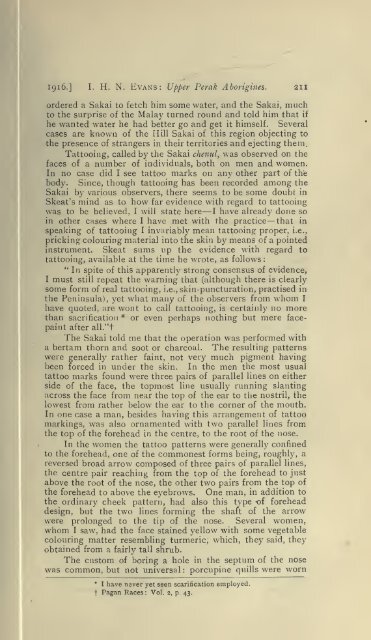Journal of the Federated Malay States museums - Sabrizain.org
Journal of the Federated Malay States museums - Sabrizain.org
Journal of the Federated Malay States museums - Sabrizain.org
Create successful ePaper yourself
Turn your PDF publications into a flip-book with our unique Google optimized e-Paper software.
Igi6.] 1. H. N. Evans: Upper Perak Aborigines. ail<br />
ordered a Sakai to fetch him some water, and <strong>the</strong> Sakai, much<br />
to <strong>the</strong> surprise <strong>of</strong> <strong>the</strong> <strong>Malay</strong> turned round and told him that if<br />
he wanted water he had better go and get it himself. Several<br />
cases are known <strong>of</strong> <strong>the</strong> Hill Sakai <strong>of</strong> this region objecting to<br />
<strong>the</strong> presence <strong>of</strong> strangers in <strong>the</strong>ir territories and ejecting <strong>the</strong>m.<br />
Tattooing, called by <strong>the</strong> Sakai chenul, was observed on <strong>the</strong><br />
faces <strong>of</strong> a number <strong>of</strong> individuals, both on men and women.<br />
In no case did I see tattoo marks on any o<strong>the</strong>r part <strong>of</strong> <strong>the</strong><br />
body. Since, though tattooing has been recorded among <strong>the</strong><br />
Sakai by various observers, <strong>the</strong>re seems to be some doubt in<br />
Skeat's mind as to how far evidence with regard to tattooing<br />
was to be believed, I will state here— I have already done so<br />
in o<strong>the</strong>r cases where I have met with <strong>the</strong> practice— that in<br />
speaking <strong>of</strong> tattooing I invariably mean tattooing proper, i.e.,<br />
pricking colouring material into <strong>the</strong> skin by means <strong>of</strong> a pointed<br />
instrument. Skeat sums up <strong>the</strong> evidence with regard to<br />
tattooing, available at <strong>the</strong> time he wrote, as follows<br />
" In spite <strong>of</strong> this apparently strong consensus <strong>of</strong> evidence,<br />
I must still repeat <strong>the</strong> warning that (although <strong>the</strong>re is clearly<br />
soine form <strong>of</strong> real tattooing, i.e., skin-puncturation, practised in<br />
<strong>the</strong> Peninsula), yet what many <strong>of</strong> <strong>the</strong> observers from whom I<br />
have quoted, are wont to call tattooing, is certainly no more<br />
than sacrificatioii * or even perhaps nothing but mere facepaint<br />
after all."t<br />
The Sakai told me that <strong>the</strong> operation was performed with<br />
a bertam thorn and soot or charcoal. The resulting patterns<br />
were generally ra<strong>the</strong>r faint, not very much pigment having<br />
been forced in under <strong>the</strong> skin. In <strong>the</strong> men <strong>the</strong> most usual<br />
tattoo marks found were three pairs <strong>of</strong> parallel lines on ei<strong>the</strong>r<br />
side <strong>of</strong> <strong>the</strong> face, <strong>the</strong> topmost line usually running slanting<br />
across <strong>the</strong> face from near <strong>the</strong> top <strong>of</strong> <strong>the</strong> ear to <strong>the</strong> nostril, <strong>the</strong><br />
lowest from ra<strong>the</strong>r below <strong>the</strong> ear to <strong>the</strong> corner <strong>of</strong> <strong>the</strong> mouth.<br />
In one case a man, besides having this arrangement <strong>of</strong> tattoo<br />
markings, was also ornamented with two parallel lines from<br />
<strong>the</strong> top <strong>of</strong> <strong>the</strong> forehead in <strong>the</strong> centre, to <strong>the</strong> root <strong>of</strong> <strong>the</strong> nose.<br />
In <strong>the</strong> women <strong>the</strong> tattoo patterns were generally confined<br />
to <strong>the</strong> forehead, one <strong>of</strong> <strong>the</strong> commonest forms being, roughl)^ a<br />
reversed broad arrow composed <strong>of</strong> three pairs <strong>of</strong> parallel lines,<br />
<strong>the</strong> centre pair reaching from <strong>the</strong> top <strong>of</strong> <strong>the</strong> forehead to just<br />
above <strong>the</strong> root <strong>of</strong> <strong>the</strong> nose, <strong>the</strong> o<strong>the</strong>r two pairs from <strong>the</strong> top <strong>of</strong><br />
<strong>the</strong> forehead to above <strong>the</strong> eyebrows. One man, in addition to<br />
<strong>the</strong> ordinary cheek pattern, had also this type -<strong>of</strong> forehead<br />
design, but <strong>the</strong> two lines forming <strong>the</strong> shaft <strong>of</strong> <strong>the</strong> arrow<br />
were prolonged to <strong>the</strong> tip <strong>of</strong> <strong>the</strong> nose. Several women,<br />
whom I saw, had <strong>the</strong> face stained yellow with some vegetable<br />
colouring matter resembling turmeric, which, <strong>the</strong>y said, <strong>the</strong>y<br />
obtained from a fairly tall shrub.<br />
The custom <strong>of</strong> boring a hole in <strong>the</strong> septum <strong>of</strong> <strong>the</strong> nose<br />
was common, but not universal: porcupine quills were worn<br />
* I have never yet seen scarification employed.<br />
t Pagan Races: Vol. 2, p. 43.

















